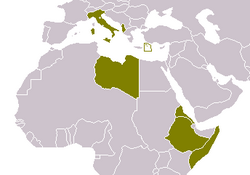Ethiopian Christianity: Difference between revisions
No edit summary |
No edit summary |
||
| Line 23: | Line 23: | ||
{{Bottom of Page}} | {{Bottom of Page}} | ||
[[Category:Doctrines]] | |||
[[Category:The Seven Church Ages]] | |||
[[Category:Church history]] | |||
Latest revision as of 23:46, 23 August 2015

This article is one in a series on the history of the Church - you are currently on the topic that is in bold:
- Church History
- Early Heretics
- Popes Through History
- Ethiopian Christianity
- Non-Catholic Christians
- Individual Christians
- Persecuting Christians
- The Date of Easter
Ethiopia in the Bible
The nation of Ethiopia is mentioned a number of times in the Bible. The Queen of Sheba (possibly Ethiopia) met with Solomon c. 950 B.C. (I Kings 10:1), and the treasurer of Ethiopia (a eunuch serving under Candace, Queen of Ethiopia) was baptized by the disciple Philip (Acts 8:27).
Frumentius the Slave
A man named Frumentius, once a slave in Ethiopia, returned as a missionary and baptized King Ezana, who declared Ethiopia a Christian nation in 340 A.D.[1] Ethiopia developed in relative isolation from European Christianity.
Ethiopia and Europe
For a time, Ethiopia was completely cut off from European influence when the Muslims conquered North Africa until 1508 A.D., when Portugal and Ethiopia established diplomatic relations. By 1624 the Portugese influence resulted in the conversion of Emperor Susenyos to Roman Catholicism. However all Europeans, Jesuits, and Catholic converts were expelled in 1632 by Susenyos' son, Emperor Fasilides, who had read of the Jesuits' bloody inquisitions in other nations.
By the late 1880's, many European nations were scrambling to claim portions of Africa as colonies. Italy purchased Eritrea from an Afar Sultan (a vassal of the Ethiopian Empire), which led to various battles between Ethiopia and Italy. Italy also claimed part of the bordering nation of Somalia. In 1896, at the Battle of Adowa, Ethiopia shocked the world by defeating Italy, which resulted in a treaty of peace on October 26, 1896.
Mussolini Invades Ethiopia

In September 1934, Italy affirmed its 1928 treaty of friendship with Ethiopia, although the borders between the countries were unclear. At the same time, however, Italian troops began amassing in Italian Somaliland. On October 3, 1935, 100,000 Italian soldiers and a number of Askari attacked Ethiopia from Eritrea and Italian Somaliland without a declaration of war. On October 7, the League of Nations unanimously declared Italy an aggressor but took no effective action.
Besides lacing bombs with mustard gas, the Italians instituted forced labor camps, installed public gallows, killed hostages, and mutilated the corpses of their enemies. Captured guerrillas were thrown out of airplanes in mid-flight, and Italian troops photographed themselves next to cadavers hanging from the gallows, and hanging around chests full of detached heads. The war lasted 7 months, with Ethiopia outmatched by Italy in armaments and brutality. The Italian king, Victor Emmanuel III, was proclaimed the new emperor of Italian East Africa on May 9, 1937 (which merged Eritrea, Ethiopia and Somaliland into a single state).
The Italians showed favoritism to non-Christian ethnicities (i.e. non-Ethiopian Orthodox and non-protestant people) such as the Oromo, Somali, and other Muslims (some of whom had supported the Italian invasion) in an attempt to isolate the Amhara, who had supported Emperor Haile Selassie. With Pope Pius XI silent on Mussolini's unprovoked and terrible conquest of Christian Ethiopia, the bloody Inquisition feared by Emperor Fasilides in 1624 A.D. had finally materialized.
On June 30, deposed Ethiopian Haile Selassie made a moving speech before the League of Nations in Geneva in which he set forth two choices--support for collective security or international lawlessness. He warned that "It is us today. It will be you tomorrow". As a result of the League's condemnation of Italy, Mussolini declared the country's withdrawal from the organization. In June 1940 Italy entered World War II on the side of Germany. As a result, Britain sought to cooperate with Ethiopian and other forces in a attempt to dislodge the Italians from Ethiopia and from British Somaliland. Ethiopia was finally liberated from Italian control in East African Campaign in 1941.
Footnotes
- ↑ Jones, Terry, "Frumentius of Ethiopia", (May 8 2007) in http://www.catholic-forum.com/saints/saintf06.htm